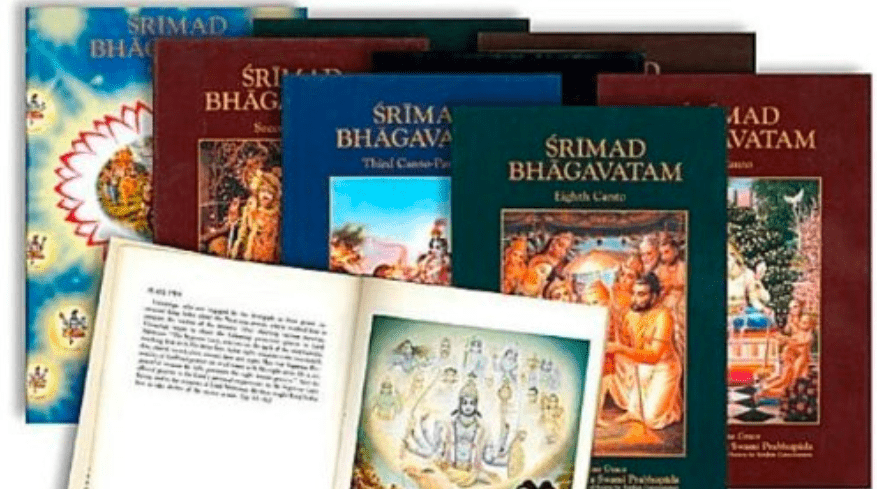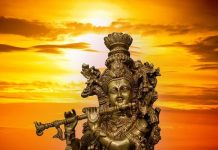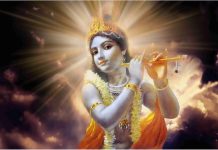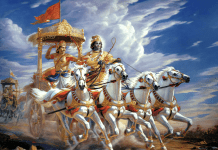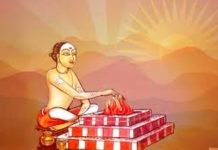Srimad Bhagavatam, Mahatmyam, Chapter Two Sloka 61: Bhakti Gnyana..The learned Sanath Kumaras continue to tell Sage Narada the following: By mere listening to Srimad Bhagavatam, Bhakti, Gyana (wisdom) and Vairagya (detachment) would gain strength. Gyana and Vairagya would be able to stay without getting weak. Bhakti will be extremely contended. That is the power of the Holy Text.
Srimad Bhagavatam, Mahatmyam, Chapter Two Sloka 62: Pralayam he Srimad Bhagavatam…Srimad Bhagavatam has the power to destroy all the evil effects of Kaliyuga.
Srimad Bhagavatam, Mahatmyam, Chapter Two Sloka 63: Gnyana Vairagya…Through Srimad Bhagavatam, Bhakti, along with Gnyana and Vairagya, would spread love and peace in every household.
Srimad Bhagavatam, Mahatmyam, Chapter Two Sloka 64: Narada Uvacha, Veda vedanta… 65: Srimad Bhagavatam kathal:, 66: Chintu…65: Sage Narada said: Even through the narration of Vedas, Upanishads and Bhagawat Gita, Gnyana and Vairagya could not gain strength; such being the case, how can Srimad Bhagavatam help? Oh, learned souls (Sanath Kumaras), please clear my doubt.
Srimad Bhagavatam, Mahatmyam, Chapter Two Sloka 67: Kumara Uvacha: Vedoupanishadam…68: Aamoola…69: Yadha; 70: Ikshuma…; 71: Idham Bhagavatam…
Sanath Kumaras were a bit surprised and amused at the doubt that emanated in Sage Narada’s mind. Actually, Sage Narada did not have any doubt, but it is for the benefit of the common man or devotees who may have such doubts, that the Muni puts forth the queries. Replying to sage Narada the Kumaras said that the story of Srimad Bhagavatam is nothing but the very essence both the Vedas and the Upanishads. The Vedas and the Upanishads cannot exist without the Bhakthi – the very essence of Srimad Bhagavatam. At the same time, Vedas and Upanishads cannot be separated from the Bhagavatam (67).

Sanath Kumaras, for the benefit of the common man, give a series of examples to illustrate the essence of Bhagavatam. In the first illustration, the Kumaras say that every tree takes its energy from the roots upto the very top leaf. But one cannot taste the end product of this is energy. However, the essence of this energy is available in the form of a fruit. The Vedas and the Upanishads are the energies and Srimad Bhagavatam is the fruit (68).
(The famous learned soul, Sri Ramakrishna Paramahamsa, had once told his disciples that one could investigate to find out the length of a mango tree, the depths of its roots, number of branches and leaves etc to find to find out how a mango was formed; but an easier way is to just consume the mango and one can taste be bliss given by the tree. That is what true bhakts do)
In yet another illustration, the Kumaras say that one cannot taste ghee by merely drinking milk. But when milk is turned into curds and churned, one gets butter; when this butter is clarified, ghee emerges. It must be noted that ghee is the final product. Similarly, when the Vedas and the Upanishads are churned and clarified, one gets the essence called Srimad Bhagavatam. And, like ghee, Srimad Bhagavatam is the final product. In so far as Bhakthi is concerned, there is nothing beyond Srimad Bhagavatam. (69)
In another example, the Kumaras say that sugar cannot be directly tasted from sugarcane. But through a series of processes, one can get the end product called sugar. The same is the case with Srimad Bhagavatam. One cannot taste Bhakthi only through Vedas and Upanishads, but since Srimad Bhagavatam is the essence, it is the ultimate in sweetness (Bhakthi). (70)
Srimad Bhagavatam occupies the same pedestal as Vedas and this was enunciated by none other than Sage Veda Vyasa. (71)
Srimad Bhagavatam, Mahatmyam, Chapter Two Sloka 72: Vedanta veda…73: Thatha twaya…74: Thatrate vismaya…
The Kumaras then gently remind Narada on how he had once lifted the spirits of Veda Vyasa by narrating the essence of Srimad Bhagavatam in four couplets (slokas, known as chathursloki Bhagavatam). That being the case, the Kumaras wonder how Narada had this doubt on the importance and power of Srimad Bhagavatam.(72 & 73)
The Kumaras continue to gently remind Narada and expressed surprise on what prompted him to ask this question on the power of Srimad Bhagavatam, They then tell the sage to narrate Srimad Bhagavatam to Gyana and Vairaghya and drive away their sorrows.(74)
Interpretation: Here too Sanat Kumaras are actually addressing the common man/devotees through Sage Narada. Some of us have doubt whether the Vedas are powerful or the Upanishads. Can Bhagavatam replace these two texts. The learned Sanat Kumaras emphatically puts this doubt to rest and establishes the supremacy of Srimad Bhagavatam.
Srimad Bhagavatam, Mahatmyam, Chapter Two Sloka 75…Narada uvacha: Yadarshanam…76: Bhagyaodayana…
An enlightened Narada praises Sanat Kumaras and says that they are able to have a clarity of thought because they are always engaged and immersed in drinking the very essence of Srimad Bhagavatam that was sung by all the thousand heads of Lord Shesha. I (Narada) have sought to clear my doubt and seek refuge in your wisdom (75).
It is only through a series of good deeds in past lives that one would have the good fortune to be in the company of holy men and saints and those who are immersed in Bhakthi. It is only then that wisdom dawns. The darkness of ignorance is then driven out from one’s mind. And one sees only Bhakthi and pure joy (76).
This ends the second chapter entitled `A dialogue between Kumaras and Narada’. This forms part of `glory of Srimad Bhagavatam’ in Uttarakanda of the glorious Padmapurna.


























